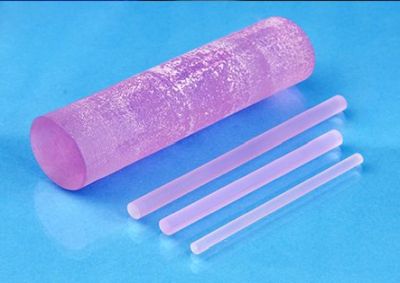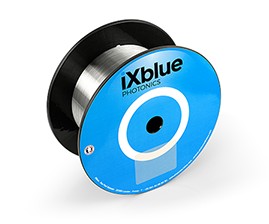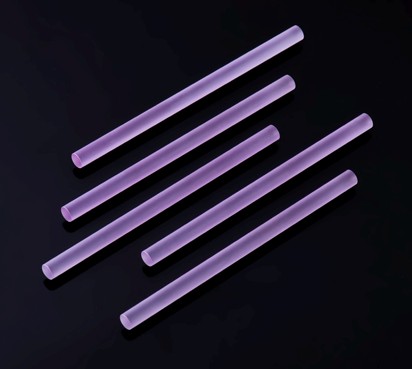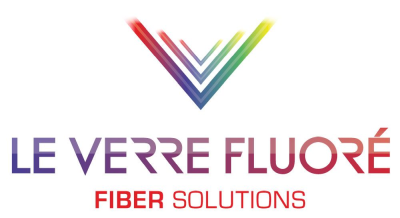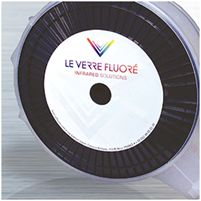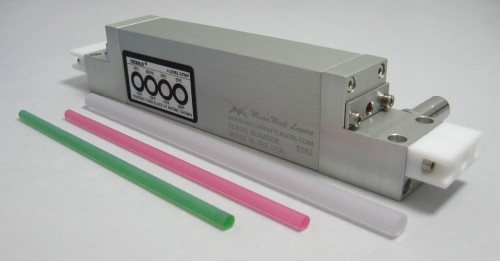laser gain media (original) (raw)
Author: the photonics expert (RP)
Definition: media for laser amplification
Alternative terms: active media, active laser media
More specific terms: ceramic laser gain media, rare-earth-doped laser gain media, transition-metal-doped laser gain media, chromium-doped laser gain media, erbium-doped laser gain media, neodymium-doped laser gain media, praseodymium-doped laser gain media, thulium-doped laser gain media, ytterbium-doped laser gain media, four-level and three-level laser gain media, quasi-three-level laser gain media, laser crystals, rare-earth-doped fibers
Categories:  optical materials,
optical materials,  laser devices and laser physics,
laser devices and laser physics,  optical amplifiers
optical amplifiers
DOI: 10.61835/z5z [Cite the article](encyclopedia%5Fcite.html?article=laser gain media&doi=10.61835/z5z): BibTex plain textHTML Link to this page LinkedIn
Within the context of laser physics, a laser gain medium is a medium which can amplify the power of light (typically in the form of a light beam). Such a gain medium is required in a laser to compensate for the resonator losses, and is also called an active laser medium, in contrast to passive optical elements, not providing amplification. It can also be used for application in an optical amplifier. The term gain refers to the amount of amplification.
As the gain medium adds energy to the amplified light, it must itself receive some energy through a process called pumping, which may typically involve electric currents (electrical pumping) or some light inputs (→ optical pumping), typically at a wavelength which is shorter than the signal wavelength.
There are a variety of very different gain media; the most common of them are:
- Certain direct band gap semiconductors such as gallium arsenide, indium gallium arsenide or gallium nitride are typically pumped with electric currents, often in the form of quantum wells (→ semiconductor lasers). A substantially different amplification mechanism is utilized in quantum cascade lasers, another type of semiconductor lasers.
- Certain laser crystals and glasses such as Nd:YAG (neodymium-doped yttrium aluminum garnet → YAG lasers), Yb:YAG (ytterbium-doped YAG), Yb:glass, Er:YAG (erbium-doped YAG), or Ti:sapphire are used in the form of solid pieces (→ bulk lasers) or optical glass fibers (→ fiber lasers, fiber amplifiers). These crystals or glasses are doped with some laser-active ions (in most cases trivalent rare earth ions, sometimes transition metal ions) and optically pumped. Lasers based on such media are sometimes called doped insulator lasers.
- There are ceramic laser gain media, which are also normally doped with rare earth ions.
- Laser dyes are used in dye lasers, typically in the form of liquid solutions.
- Gas lasers are based on certain gases or gas mixtures, typically pumped with electrical discharges (e.g. in CO2 lasers and excimer lasers).
- More exotic gain media are chemical gain media (converting chemical energy to optical energy), nuclear pumped media, and undulators in free electron lasers (transferring energy from a fast electron beam to a light beam).
Compared with most crystalline materials, ion-doped glasses usually exhibit much broader amplification bandwidths, allowing for large wavelength tuning ranges and the generation of ultrashort pulses. Drawbacks are inferior thermal properties (limiting the achievable output powers) and lower laser cross-sections, leading to a higher threshold pump power and (for passively mode-locked lasers) to a stronger tendency for Q-switching instabilities. See the article on laser glasses for more details.
The doping concentration of crystals, ceramics and glasses often has to be carefully optimized. A high doping density may be desirable for good pump absorption in a short length, but may lead to energy losses related to quenching processes, e.g. caused by upconversion via clustering of laser-active ions and energy transport to defects.
Important Physical Effects
In most cases, the physical origin of the amplification process is stimulated emission, where photons of the incoming beam trigger the emission of additional photons in a process where e.g. initially excited laser ions enter a state with lower energy. Here, there is a distinction between four-level and three-level laser gain media, and others are quasi-three-level laser gain media.
A less frequently used amplification process is stimulated Raman scattering, involving the conversion of some higher-energy pump photons into lower-energy laser photons and phonons (related to vibrations e.g. of the crystal lattice).
For high levels of input light powers, the gain of a gain medium saturates, i.e., is reduced. This naturally follows from the fact that for a finite pump power an amplifier cannot add arbitrary amounts of power to an input beam. In laser amplifiers, saturation is related to a decrease in population in the upper laser level, caused by stimulated emission.
Thermal effects can occur in gain media because part of the pump power is converted into heat. The resulting temperature gradients and also subsequent mechanical stress can cause thermal lensing effects, distorting the amplified beam, and there can also be depolarization loss. Thermal effects can spoil the beam quality of a laser, reduce its efficiency, and sometimes even destroy the gain medium (thermal fracture).
A great variety of physical properties of a gain medium can be relevant for use in a laser. The desirable properties include:
- a laser transition in the desired wavelength region, preferably with the maximum gain occurring in this region
- a high transparency of the host medium in this wavelength region
- a pump wavelength for which a good pump source is available (in the case of an optically pumped laser); efficient pump absorption
- a suitable upper-state lifetime: long enough for Q-switching applications, short enough if fast modulation of the power is required
- a high quantum efficiency, obtained via a low prevalence for quenching effects, excited-state absorption and the like, but also possibly by strong enough beneficial effects such as certain multi-phonon transitions or energy transfers
- ideally, four-level behavior because quasi-three-level behavior introduces various additional constraints
- robustness and a long lifetime, chemical stability
- for solid-state laser gain media: a host medium which is available with good optical quality in the required size, can be cut and polished with good quality (appropriate hardness), allows for high doping with laser-active ions without clustering, is chemically stable (e.g., not hygroscopic), and has a good thermal conductivity and low thermo-optic coefficients (for weak thermal lensing in high-power operation) and high resistance to mechanical stress; optical isotropy can be desirable, but in other cases birefringence (reducing thermal depolarization) and possibly polarization-dependent gain is preferable (see also: polarization of light)
- for high gain, low threshold pump power: a high product of emission cross-section and upper-state lifetime (<$\sigma -\tau$> product)
- for low beam quality requirements on the pump source: high pump absorption may be helpful
- for wavelength tuning: a large gain bandwidth
- for ultrashort pulse generation: a broad and smoothly shaped gain spectrum; suitable chromatic dispersion and nonlinearity are also sometimes important
- for passive mode locking without Q-switching instabilities: high enough laser cross-sections
- for high energy pulse amplification (e.g. in regenerative amplifiers): a high optical damage threshold and not too high saturation fluence of the gain
Note that in many situations there are partially conflicting requirements. For example, a very low quantum defect is not compatible with four-level behavior. A large gain bandwidth typically means that laser cross-sections are smaller than ideal, and that the quantum defect cannot be very small. Disorder in solid-state laser gain media increases the gain bandwidth, but also reduces the thermal conductivity. A short pump absorption length can be advantageous, but also tends to exacerbate thermal effects.
It is apparent that different situations lead to very different requirements on gain media. For this reason, a very broad range of gain media will continue to remain important for applications, and making the right choice is essential for constructing lasers with optimum performance. For that purpose, quantitative laser modeling and simulation is often helpful.
More to Learn
Encyclopedia articles:
Suppliers
The RP Photonics Buyer's Guide contains 47 suppliers for laser gain media. Among them:
GWU-Lasertechnik
Crystalline laser gain media are know as most reliable and efficient. GWU offers all common laser crystals (Nd:YVO4, Nd:YAG, Yb:YAG etc.) with a broad variety of specifications. Besides the well-established materials, innovative crystals with outstanding properties like Yb:CALGO can open new horizons for demanding laser applications. No matter if individual pieces for R & D purposes are required or cost-efficient numbers in small, medium or large batches with in-time delivery for the production line are needed: GWU’s dedicated service helps to find the best core components for your application. GWU-Lasertechnik has more than 30 years of experience in distributing laser crystals. Choose GWU to benefit from our wide knowledge and in-field experience!
EKSMA OPTICS
EKSMA Optics offers a variety of laser crystal materials like neodymium-doped yttrium aluminum garnet (Nd:YAG), Yb-doped potassium gadolinium tungstate (Yb:KGW), Yb-doped potassium yttrium tungstate (Yb:KYW), Nd-doped potassium gadolinium tungstate (Nd:KGW) and titanium-doped sapphire (Ti:sapphire).
Exail
Exail (formerly iXblue) offers a wide range of specialty optical fibers for lasers and amplifiers. We master erbium, erbium/ytterbium, ytterbium, thulium, holmium, thulium/holmium, neodymium, dysprosium, and phosphorous gain media. PM version are available, and Large Mode Area (LMA) or Very Large Mode Area (VLMA) versions as well. Depending of the requirement, single clad fibers are available for core pumping, double clad fibers for clad pumping. Triple clad and all glass structures are also available.
Shalom EO
Shalom EO offers a variety of rare-earth-doped laser crystals, including crystals made of
- Nd:YAG
- Nd:Ce:YAG
- Nd:YVO4
- CTH:YAG crystals
- Er:YAG crystals
- Yb:YAG crystals
- Ti:sapphire crystals
and also diffusion-bonded crystals. Nd:YAG crystals and Nd:YVO4 crystals are ideal for 1064-nm lasers, while Nd:Ce:YAG, CTH:YAG and Er:YAG crystals are excellent for medical and cosmetic laser applications. Ti:sapphire crystals are ideal for ultrafast laser systems, and diffusion-bonded crystals are suitable for OEM compact laser systems.
Fibercore
Fibercore has delivered over 40 years of innovation and excellence in developing and manufacturing speciality optical fiber. All of our fiber products have been developed with our customers in mind with market leading capabilities to produce an extensive range of fibers including;
- single-mode (SM) fiber
- doped fiber
- polarization-maintaining (PM) fiber
- multimode (MM) fiber
- multicore fiber
- spun HiBi fiber
We are continuously expanding our product ranges to cover wider and more demanding customer applications. So if you have a specific development project or require a custom fiber, we would like to discuss it further with you. We will work together with you to find the best solution.
Le Verre Fluore
Thanks to their high rare-earth solubility (up to 100,000 ppm) and low phonon energy, LVF fluoride fibers offer dozens of active transitions, enabling a broad range of applications from visible to the mid-infrared. LVF offers the largest range of rare-earth doped fibers in the world.
LVF active fibers are available as RE doped single-mode fibers and rare-earth-doped double cladding fibers.
Megawatt Lasers
MegaWatt Lasers Inc. has a large inventory of Nd:YAG, Er:YAG and CTH:YAG laser rods. We also can assist in the design and modeling for various applications.
Laserton
Laserton offers various types of laser crystals based on materials like Nd:YAG, Nd:YVO4, Yb:YAG and Cr4:YAG.
Also, Laserton offers gain chips based on Er:Yb:glass, which is bonded to a Co:Mg:Al2O4 saturable absorber crystal for passive Q switching. These can be used to produce eye-safe lasers emitting at 1535 nm, pumped with a laser diode at 940 nm.
Questions and Comments from Users
Here you can submit questions and comments. As far as they get accepted by the author, they will appear above this paragraph together with the author’s answer. The author will decide on acceptance based on certain criteria. Essentially, the issue must be of sufficiently broad interest.
Please do not enter personal data here. (See also our privacy declaration.) If you wish to receive personal feedback or consultancy from the author, please contact him, e.g. via e-mail.
By submitting the information, you give your consent to the potential publication of your inputs on our website according to our rules. (If you later retract your consent, we will delete those inputs.) As your inputs are first reviewed by the author, they may be published with some delay.

